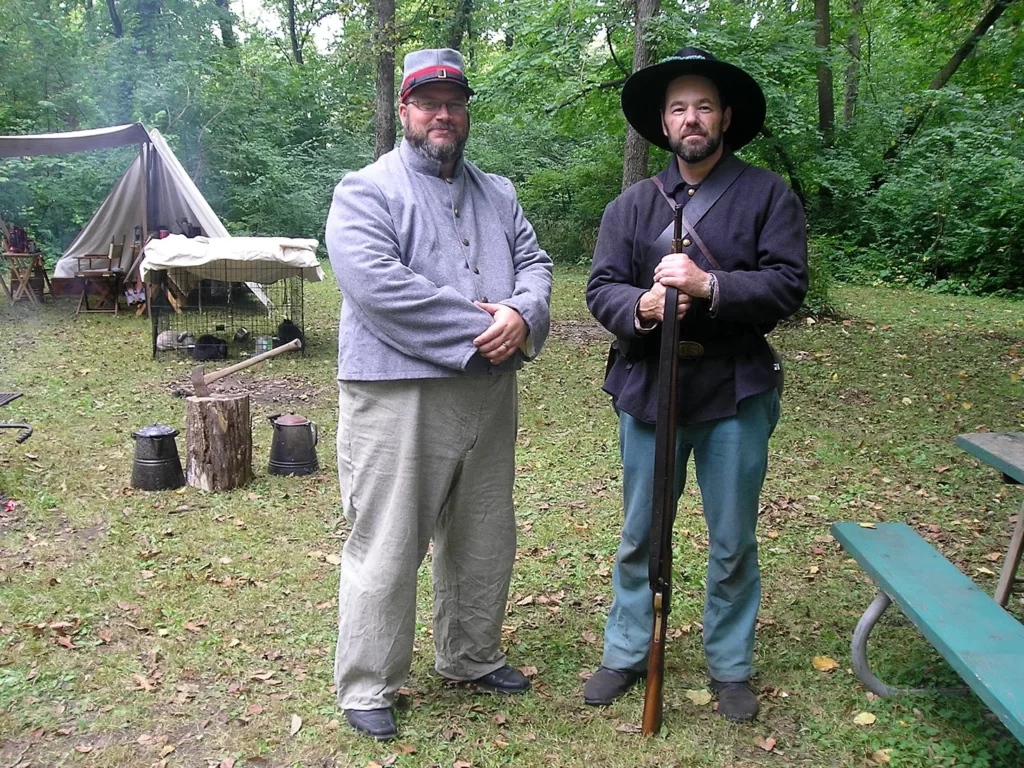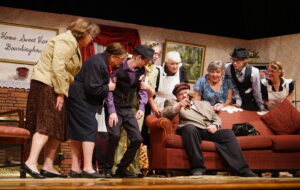Civil War comes to Clark’s Park
DISPATCH FROM THE FRONT!

Chris Timper of Davenport, left, and Brian Scott of Muscatine, right, participated in a Civil War weekend Saturday, September 20, 2025, at T.F. Clark Park in Tama County, Iowa. The small number of attendees meant small-scale exchanges of fire. PHOTO BY THE AUTHOR
TRAER – As the 21st century starts its second quarter, the number of people interested in portraying and imitating the lives of those from the middle of the 19th — specifically, Civil War re-enactors — is shrinking.
“This is a dying art form,” Krystyna Jones said.
Jones is chair of the Traer Civil War Reenactment Committee. She has been active in re-enactment circles for nearly 30 years. The committee has started a yearly event on the third weekend in September in Clark’s Park in northern Tama County. This was its second year.
Jones’ mother watched Gone With the Wind a lot and Jones thought, “Why not put myself in the middle of it?” She got involved with a Mason City group that replicates the 8th Texas Company K Cavalry and Battery B. She has worked her way up to sergeant of artillery in that organization, which took many years. “I can do an artillery piece in my sleep,” she said. All live firing is done with black powder.
The role of women in the Civil War is often overlooked, especially on the military side. There were vivianderes, women who provided supplies, food, and comfort (yes, that kind of comfort). There were even women who disguised themselves as men to fight. Dr. Mary Walker typically wore men’s clothes, although she never assumed a male identity, and she became both the first female surgeon in the U.S. Army and the only female recipient of the Medal of Honor to date.
Jones tries to attend three events a year, but that depends on scheduling and location. In eastern Iowa and northwest Illinois, there are events in Mason City, Keokuk, Galena, and Galesburg. Tiny Hopkinton, Iowa, has Civil War Days; in that era it had a new institute of higher learning, later named Lenox College (which, according to the National Park Service, suspended student Mary Walker when she refused to quit the all-male debate team).
For the event in Clark’s Park, re-enactors portraying members of Confederate units and sympathizers (nine) outnumbered the participants in Federal blue (two).
Larry Holmes of Clinton called himself a “49-year veteran of the Civil War.” He got started with re-enactments when he was 16 and will soon be 65. He brought the big gun for this battle, a 3-inch ordnance rifle. It’s on a trailer labeled “3rd Iowa Lt. Artillery,” but here, it’s part of Dance’s Artillery, Powhatan Battery, Army of Northern Virginia.
Holmes doesn’t have any actual U.S. military service, but Chris Timper of Davenport does (Marines). He has known Holmes for a long time and Holmes finally persuaded him “to come out and play.”
“We get to shoot at each other and we have fun” camping, he said. He also sees the events as a way to teach history and clear up misconceptions of the everyday soldier.
Kassi Crossman of Strawberry Point was signed up as a civilian, but she has extensive re-enactment experience. She joked that she was “tricked” into the hobby, getting started by riding horses and shooting guns. She has portrayed mounted cavalry and a soldier from the 3rd Arkansas Infantry.
Crossman has done the hardcore version of re-enacting: a weeklong event in Kentucky, with rations matching what soldiers had during the war. That ration pack included a pound of salt pork, dried soup mixes, and the infamous hardtack– “the worst tasting thing you can imagine.”
Brian Scott of Muscatine was carrying the flag for the Union. He has ancestors who fought on both sides of the war. It was his fifth-grade teacher who got him interested in re-enacting. He’s been to Gettysburg to do it twice. “I see the value of portraying what the states were standing for and the conflict in what they were doing,” he said.
Early Saturday afternoon, “Annie Wittenmyer” of Keokuk (portrayed by Jo Porter of Denver, Iowa) took time out of her advocacy for war orphans to talk to the small group assembled at the park. She talked about what the women of the Iowa home front did during the Civil War. They supplied the soldiers with cloth goods, including pillowcases and “housewife” sewing kits to patch uniforms. They were also nurses at hospitals, including multiple hospitals in Keokuk.
Wittenmyer noticed that the food being fed to the wounded soldiers was of poor quality and not good for recovery. She pioneered efforts to get healthier food for them. That included root vegetables, some of which were grown in Cedar Falls on donated land and taken by horse-drawn wagon to the nearest train station. After the war, she became the first president of the Women’s Christian Temperance Union.
Skirmishes were scheduled in the park for later in the afternoon and after sunset with “night-fire.” A military ball was also on the schedule.
Sunday morning began with the Union in retreat (Scott was packing up to leave). A period-accurate church service was held. Timper and Holmes had a few charges left for the ordnance rifle, and fired them off in a final salute to the hundreds of thousands of men who died in the war.
Jeff Morrison is the writer behind the website “Iowa Highway Ends.” He grew up in Traer and now lives in Cedar Rapids. A version of this column was originally published in the Between Two Rivers newsletter on Substack, betweentworivers.substack.com. It is republished here through the Iowa Writers’ Collaborative. Please consider subscribing to the collaborative at iowawriters.substack.com and the authors’ blogs to support their work.





